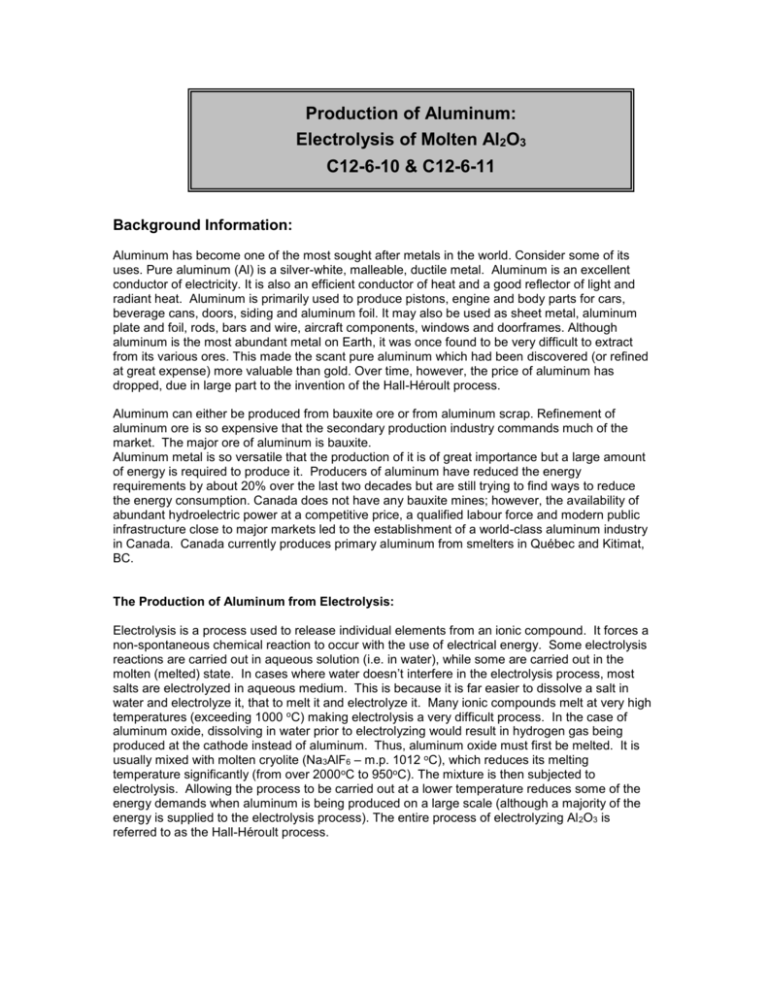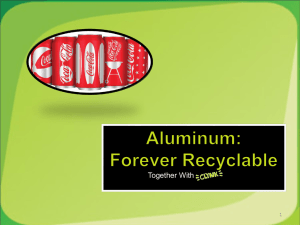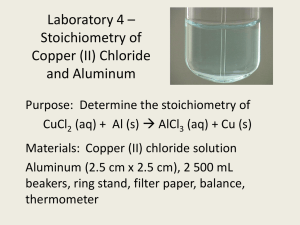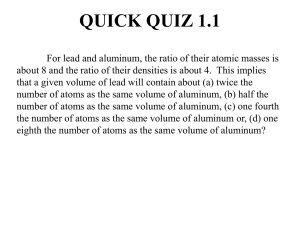Production of Aluminum
advertisement

Production of Aluminum: Electrolysis of Molten Al2O3 C12-6-10 & C12-6-11 Background Information: Aluminum has become one of the most sought after metals in the world. Consider some of its uses. Pure aluminum (Al) is a silver-white, malleable, ductile metal. Aluminum is an excellent conductor of electricity. It is also an efficient conductor of heat and a good reflector of light and radiant heat. Aluminum is primarily used to produce pistons, engine and body parts for cars, beverage cans, doors, siding and aluminum foil. It may also be used as sheet metal, aluminum plate and foil, rods, bars and wire, aircraft components, windows and doorframes. Although aluminum is the most abundant metal on Earth, it was once found to be very difficult to extract from its various ores. This made the scant pure aluminum which had been discovered (or refined at great expense) more valuable than gold. Over time, however, the price of aluminum has dropped, due in large part to the invention of the Hall-Héroult process. Aluminum can either be produced from bauxite ore or from aluminum scrap. Refinement of aluminum ore is so expensive that the secondary production industry commands much of the market. The major ore of aluminum is bauxite. Aluminum metal is so versatile that the production of it is of great importance but a large amount of energy is required to produce it. Producers of aluminum have reduced the energy requirements by about 20% over the last two decades but are still trying to find ways to reduce the energy consumption. Canada does not have any bauxite mines; however, the availability of abundant hydroelectric power at a competitive price, a qualified labour force and modern public infrastructure close to major markets led to the establishment of a world-class aluminum industry in Canada. Canada currently produces primary aluminum from smelters in Québec and Kitimat, BC. The Production of Aluminum from Electrolysis: Electrolysis is a process used to release individual elements from an ionic compound. It forces a non-spontaneous chemical reaction to occur with the use of electrical energy. Some electrolysis reactions are carried out in aqueous solution (i.e. in water), while some are carried out in the molten (melted) state. In cases where water doesn’t interfere in the electrolysis process, most salts are electrolyzed in aqueous medium. This is because it is far easier to dissolve a salt in water and electrolyze it, that to melt it and electrolyze it. Many ionic compounds melt at very high temperatures (exceeding 1000 oC) making electrolysis a very difficult process. In the case of aluminum oxide, dissolving in water prior to electrolyzing would result in hydrogen gas being produced at the cathode instead of aluminum. Thus, aluminum oxide must first be melted. It is usually mixed with molten cryolite (Na3AlF6 – m.p. 1012 oC), which reduces its melting temperature significantly (from over 2000oC to 950oC). The mixture is then subjected to electrolysis. Allowing the process to be carried out at a lower temperature reduces some of the energy demands when aluminum is being produced on a large scale (although a majority of the energy is supplied to the electrolysis process). The entire process of electrolyzing Al 2O3 is referred to as the Hall-Héroult process. The site listed below shows an animation of this process to produce aluminum from Al2O3: http://www.sciencelessons.co.uk/example.php The diagram below is a simplified version of a typical electrolysis cell carrying out the Hall-Héroult process. Simplified reactions: Al3+ + 3 e- → Al . . . Cathode C(s) + 2 O2- → CO2 + 4 e- . . . Anode 2 Al2O3 + 3 C → 4 Al + 3 CO2 . . . Overall cell reaction 1. Draw a power source on the diagram above and indicate the direction of electron flow using electrons and arrows. Are electrons moving through the wires, the solution, or both? 2. Prior to electrolysis, the aluminum oxide is melted. Why can’t solid aluminum oxide be electrolyzed? 3. Draw aluminum (Al3+) and oxygen (O2-) ions in the solution on the diagram (previous page). Use arrows to indicate which electrode they move to during electrolysis. Write symbolic equations showing the reactions occurring at each electrode. 4. In words, describe the processes that are occurring at the anode and the cathode. 5. The net reaction occurring in the Hall-Héroult process is: 2Al2O3 + 3C --> 4Al(l) + 3CO2(g) a) Based on this reaction and the diagram of the cell (pervious page), suggest why the anodes (positive electrodes) might need to be replaced if this reaction were producing aluminum on a large-scale. b) In the diagram of the cell (previous page), the container is made of steel. Suggest the role of the steel in the electrolysis process. c) Suggest whether oxidation or reduction is occurring at the anode. Write the anode reaction (simplified equations) and show which process is occurring by using oxidation numbers. Is there a loss or gain of electrons? d) Suggest whether oxidation or reduction is occurring at the cathode. Write the cathode reaction (simplified equations) and show which process is occurring by using oxidation numbers. Is there a loss or gain of electrons? e) What evidence would you have that a chemical reaction is taking place at these electrodes? 6. When the electrolysis of Al2O3 is carried out in aqueous solution, hydrogen gas is produced at the cathode rather than aluminum. Explain. 7. The electrolysis of molten AlCl3 is similar to that of Al2O3 (except much simpler since it can be electrolyzed without the use of another substance to lower its melting point). Draw a diagram of an electrolytic cell containing molten AlCl3. Include the source of current, ions present in solution, direction of electron flow, and anode and cathode electrodes. Describe in words the processes occurring at each electrode. Also write symbolic reactions for the anode and cathode. Summary: The industrial process known as aluminum electrolysis was discovered in 1886 by Paul-Louis Toussaint Héroult and Charles Martin Hall. The process is based on the use of a powerful electric current to decompose aluminum oxide (Al2O3). Aluminum, found in the form of bauxite ore, it is first converted into pure aluminum oxide by the Bayer Process. This is then electrolyzed in solution in molten cryolite - another aluminum compound, releasing pure aluminum.






